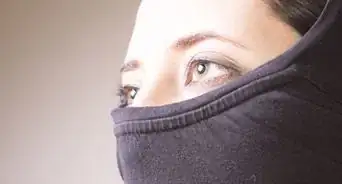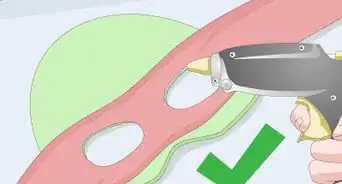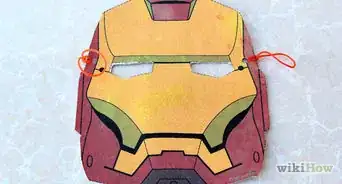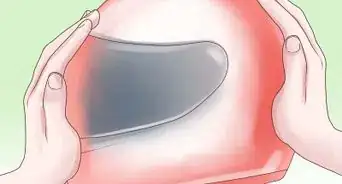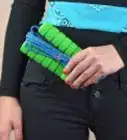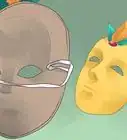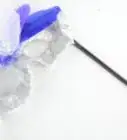This article was co-authored by wikiHow Staff. Our trained team of editors and researchers validate articles for accuracy and comprehensiveness. wikiHow's Content Management Team carefully monitors the work from our editorial staff to ensure that each article is backed by trusted research and meets our high quality standards.
The wikiHow Video Team also followed the article's instructions and verified that they work.
This article has been viewed 81,541 times.
Learn more...
Greek theater masks are known for their highly emotional expressions, the most iconic being the tragedy and comedy masks that are often used as symbols of the theater. Although none have survived to this day, we know that the masks had highly exaggerated expressions that could be seen by all theatergoers. It’s quite easy to make your Greek theater mask from materials like paper plates, cardstock, paper mâché, or plaster. After you finish making and decorating your mask, you can put on a show of your own!
Steps
Designing Your Mask
-
1Research for inspiration. Before you start making your mask, first decide on a design. Use the Internet or books on Greek theater to inspire ideas of what your mask could look like. You don’t have to base your design on these examples, but they can guide you in the right direction if you don’t know where to start.[1]
-
2Decide what emotion you want to convey. You should choose a simple but clear expression to represent. You may decide to make a mask that is happy, sad, angry, excited, etc.[2]
- If you are making the mask for a particular play, think about your character and the primary emotions they feel during the play.
- Remember that you will be poking out eye holes, so ensure your design has large, open eyes.
Advertisement -
3Draw your design. Once you have settled on a plan, draw it on a piece of paper. Even though you won’t use this paper to make your mask, recording your design will help you to remember it exactly as you wanted it.[3]
Constructing Your Mask
-
1Create a mask from paper plates or card stock. Paper plates and card stock are the easiest materials to work with to make your mask. Cut out an oval shape in the material that mimics the shape of your face. Draw your design onto the material, and use scissors to cut out the eyes and the mouth. [4]
- Before drawing on the eyes and mouth put the mask up to your face. With a pencil, make a mark where your eyes and mouth fall. Then draw the eyes and mouth over these marks and cut them out.
-
2Make a mask from papier mâché. You can also use paper mâché to build the mask around a balloon. First, inflate a regular-sized balloon and tie it. Take a couple of strips of newspaper and dip them into the bowl of decoupage glue. Then stick them onto the balloon. Do this until you have two or three layers of newspaper in roughly the shape of a mask.[5]
- Leave the paper mâché for a couple of hours to let it dry. Once it has dried, poke the balloon with a pin or other sharp object. Then peel the balloon away so you are left with just the mask.
- Cut out the eyes and the mouth. Use scissors to cut out the eye and mouth holes. If you cannot cut through the papier mâché with scissors, use an Exacto knife to cut out the holes.
-
3Make a mask with plaster bandages. By using plaster, you can mold the mask to your face so it fits perfectly. Before starting the mask, apply a layer of Vaseline around the edge of your face near your hairline, as well as over your eyebrows. Put small squares of dampened paper towel over your eyes. Then lie down and have a friend start layering on the plaster bandages by dipping them in water and putting them directly on your face. They should lay down around three layers of bandages.
- Make sure your friend keeps the eye and the mouth area open.
- Peel off the mask and wash your face to get rid of any Vaseline or plaster.
Finishing Your Mask
-
1Strengthen the mask. If you made your mask from papier mâché or bandages, you might want to reinforce your mask. If you notice any layers of the mask that poke out and interfere with the shape, trim them with scissors. Also, use glue to reinforce layers that are peeling apart from each other.
-
2Create features. If you want your mask to look more realistic, add to it to create features. If you used papier mâché you can add features like a nose by adding on more paper. You can also model features out of clay and papier mâché around them, then glue the features onto the mask.
- If you made your mask from bandages, you can also put on new bandages if you want to exaggerate the shape of certain features or reinforce thin layers.
-
3Color the mask. Now that you are done making the basic shape of the mask, go ahead and color it as you wish! You may decide to paint a flesh tone over your whole mask, and then paint on features like lips or eyebrows. You can also go for bolder, non-traditional colors. Do whatever you feel best suits your design.
- If you have made the mask from card stock or paper plates, you can use crayons, markers, or paint to color the mask.
- If you used papier mâché or bandages, you should paint your mask because crayons and markers won’t be as effective on these materials.
-
4Add hair. Many Greek theater masks also included hair. If you are happy with the way your mask looks, you don’t have to add hair. However, if you do want to add hair, use construction paper, wool, yarn, or whatever material you have available. Adding hair can make your mask look more realistic and human-like.[6]
-
5Add elastic. Poke holes on each side of the mask. String elastic through one of the holes, then tie the elastic to secure it. Do the same on the other side. Adding elastic allows you to wear your mask without holding it up so that you can use your hands freely. [7]
- If you would prefer to hold your mask, attach a stick to the bottom so you can hold it more easily in front of your face.
Community Q&A
-
QuestionDo you recommend clay, or paper plate masks? Which is easier?
 Community AnswerIt all depends on what you want. If you want something that Isn't heavy, then go with paper plate masks. Paper masks are also the easiest. If you want something heavier and more complex, go with clay.
Community AnswerIt all depends on what you want. If you want something that Isn't heavy, then go with paper plate masks. Paper masks are also the easiest. If you want something heavier and more complex, go with clay. -
QuestionWhat happens if you use too much glue? Will it affect your mask?
 Community AnswerUsing too much glue will make it look sloppy but it depends on the glue you are using. Start out with using just a little and then gradually add more as needed.
Community AnswerUsing too much glue will make it look sloppy but it depends on the glue you are using. Start out with using just a little and then gradually add more as needed.
Warnings
- Be extremely careful if you are using scissors or blades to cut your designs.⧼thumbs_response⧽
References
- ↑ http://www.ancientgreece.co.uk/staff/resources/followups/fu6/fu6.pdf
- ↑ https://greektheatre.wordpress.com/home/
- ↑ http://www.ancientgreece.co.uk/staff/resources/followups/fu6/fu6.pdf
- ↑ https://www.activityvillage.co.uk/make-a-greek-mask
- ↑ http://www.ancientgreece.co.uk/staff/resources/followups/fu6/fu6.pdf
- ↑ https://www.activityvillage.co.uk/make-a-greek-mask
- ↑ https://www.activityvillage.co.uk/make-a-greek-mask


